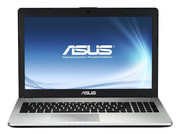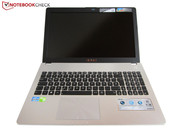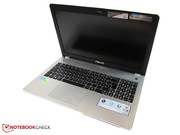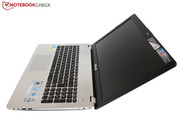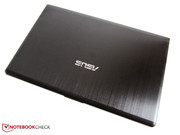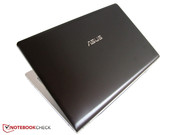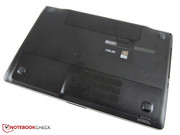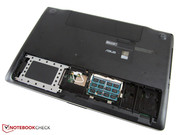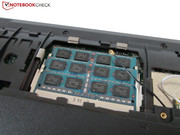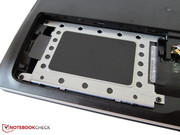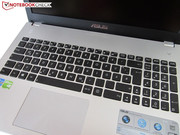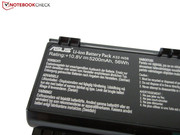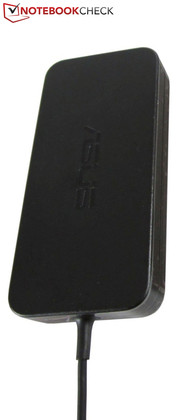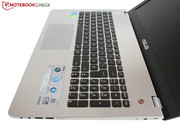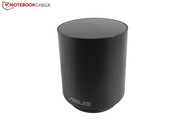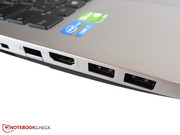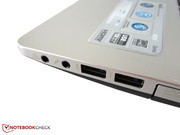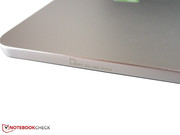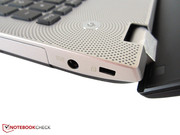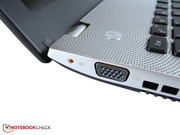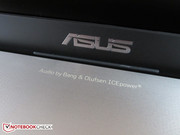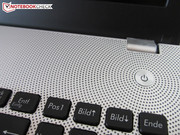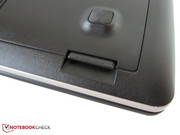Review Update Asus N56JR-S4080H Notebook

For the original German review, see here.
The Asus N56JR-S4080H is a premium multimedia laptop shipping with a GeForce GTX 760M GPU which makes it an interesting choice not only for those in need of an all-rounder, but also for gamers. The N56JR is not new to us, as we have already tested a number of almost identical (at least in terms of the chassis) predecessors such as the N56VB-S4050H (Core i7-3630QM, GeForce GT 740M) and the N56VZ-S4044V (Core i7-3610QM, GeForce GT 650M). Other than its brethren (which were rated with 85% and 84% respectively), the N56JR comes with a Haswell CPU. Our review article will show how the most recent incarnation of the N56 series fares.
In addition, we are comparing it to a number of competing devices such as the Lenovo IdeaPad Y510p (Core i7-4700MQ, GeForce GT 755M SLI) and the Samsung Ativ Book 8 Touch (Core i7-3635QM, Radeon HD 8870M).
Since the N56JR sports the same chassis as its predecessor, we are not discussing the case, its connectivity, the input device, the display and the speakers again. All of this information can be had by taking a look at the review article of the Asus N56VB-S4050H.
Features
Operating System
The Asus N56JR ships with Windows 8 (64-bit) preinstalled. Unfortunately, no recovery DVD is included. E.g. if Windows 8 were to be replaced by Windows 7, this would go along with the risk of not being able to reverse that step (unfortunately, Asus doesn't support Windows 7 and thus doesn't offer any drivers, although some Windows 8 drivers are, in fact, compatible with Windows 7). In general, all necessary drivers are available on an extra DVD, making it unnecessary to download them from Asus' website.
The obligatory drivers are the ones for the Intel graphics chip, the Intel chipset, the Intel Wi-Fi module and the card reader (the Intel drivers could be downloaded from Intel's website as well, possibly including newer versions). According to the Asus website, some N56JR models make use of Atheros Wi-Fi modules. If Asus' driver should prove not to be useable with Windows 7, a fully functional alternative should be available on Atheros.cz.
The native Windows 7 sound driver can be used, but it doesn't support the subwoofer, making it necessary to install the audio driver via Asus. The function keys as well as the backlighting system work flawlessly as soon as the "ATK Package" is installed. The GeForce GPU driver can be installed via the Windows update function. Alternatively, the most recent version can be downloaded from Nvidia's website. The correct Ethernet driver can be found on Realtek's website. Last but not least, no native Windows 7 USB 3.0 driver exists - instead the Intel USB 3.0 driver has to be installed.
Maintenance
The maintenance hatch on the bottom of the device allows the RAM modules and the hard drive to be accessed. Both memory banks are equipped with one 4 GB module each. The HDD could easily be swapped for another one, or an SSD. Both 7 mm and 9.5 mm 2.5-inch drives would fit. In order to access the fans or the CPU, however, the laptop would have to be dismantled.
Display
The N56JR uses the same matte Full HD panel as the Asus N56VB-S4050H. Still, the N56VB fares somewhat better, possibly either due to some variations during manufacturing (which is not unusual) or a deliberate choice by the manufacturer to reduce the peak brightness.
| |||||||||||||||||||||||||
Brightness Distribution: 76 %
Center on Battery: 375 cd/m²
Contrast: 647:1 (Black: 0.58 cd/m²)
ΔE ColorChecker Calman: 4.14 | ∀{0.5-29.43 Ø4.77}
ΔE Greyscale Calman: 5.25 | ∀{0.09-98 Ø5}
56.6% AdobeRGB 1998 (Argyll 1.6.3 3D)
59.9% AdobeRGB 1998 (Argyll 3D)
86.2% sRGB (Argyll 3D)
58.1% Display P3 (Argyll 3D)
Gamma: 2.48
CCT: 5699 K
In any case, the N56JR still comes with a bright, high-contrast display (which also ships with above-average viewing angles). An average DeltaE 2000 deviation value of 4 is quite good, but not great (<3). We didn't notice the slight bluish tint with our naked eyes. Still, the screen is not the ideal choice for professional graphics artists, with sRGB and AdobeRGB color space coverage rates of 77.9% and 56.6% respectively.
Performance
A number of 15.6-inch premium multimedia laptops are offered by Asus with its N56 series. These are not only suited for everyday tasks, but also video editing applications or computer games. Our test device can be had for around 1100 Euros (~$1504) at the time of writing. Another variant with a Core i5-4200H CPU is also available (the N56JR-S4056H) for around 1000 Euros (~$1367). Even cheaper (approximately 900 Euros, ~$1230) is the previous-generation N56VV-S4085H which comes with a Core i5-3230M and a GeForce GT 750M GPU.
Processor
The Asus N56JR comes with a Core i7-4700HQ CPU. This is a quad-core Haswell-generation processor which comes with a base clock speed of 2.4 GHz and a Turbo boost to up to 3.2 GHz (all four cores), 3.3 GHz (two cores) or 3.4 GHz (one core). Two preceding Ivy Bridge-generation CPUs offer the same clock speed, the Core i7-3630QM and the Core i7-3635QM (which ships with a slightly faster GPU). The latter is used in Samsung's Ativ Book. Thanks to the improvements of Haswell, the Core i7-4700HQ should be faster by 10%, with a TDP of 47 watts, 2 watts more than that of its predecessors.
The CPU works at 3.2 GHz during the single-threading CPU benchmarks. Two cores reach up to 3.3 GHz for certain stretches of time. During the multi-threading tests with all four cores, 3.2 GHz is achieved. While running on battery, however, the multi-threading performance halves since the four cores are often down-clocked from 3.2 GHz to around 800 MHz. The Cinebench results of the N56JR are on par with that of the IdeaPad (Core i7-4700MQ, GeForce GT 755M SLI) due to the almost similar CPUs while the Ativ Book (Ivy Bridge-based Core i7-3635QM at the same clock speeds, Radeon HD 8870M) does fall somewhat behind due to its older CPU and thus lower performance per MHz. During the GL tests, all three laptops yield almost the same results.
Looking at the Cinebench diagrams, the Dell Inspiron 15-7537 fares a lot worse than its competitors, due to the dual-core CPU (instead of a quad-core chip), the lower clock speeds of its CPU, and the fact that it doesn't use its Turbo mode to the fullest.
System Performance
The system runs smoothly without any noticeable lags. We also appreciate the great PCMark benchmark results, on par with those of the Ativ Book (Core i7-3635QM, Radeon HD 8870M) and the IdeaPad (Core i7-4700MQ, GeForce GT 755M SLI).
A better system performance could be achieved by replacing the HDD with a solid state drive, yielding a faster-booting, more responsive system with better PCMark results. We have actually done this, resulting in a 65% increase to 5552 points during PCMark 7 with a Crucial RealSSD C300 with 64 GB of storage.
| PCMark Vantage Result | 8774 points | |
| PCMark 7 Score | 3371 points | |
| PCMark 8 Home Score Accelerated | 3493 points | |
| PCMark 8 Creative Score Accelerated | 3538 points | |
| PCMark 8 Work Score Accelerated | 4220 points | |
Help | ||
Storage Devices
The Asus N56JR ships with an HDD made by Toshiba. It offers a capacity of 1 TB and spins with 5400 rpm. As usual for Asus laptops, the HDD is partitioned, with a system partition (372 GB) and a data partition (537 GB). CrystalDiskMark measures a read speed of 113 MB/s while HD Tune yields an average data transfer rate of 88.6 MB/s. Both are decent values, given this is an HDD with 5400 rpm. Even the above-average 4K read/write results look promising.
Graphics Card
The Asus laptop ships with Optimus technology, meaning its innards include both an integrated HD Graphics 4600 GPU for everyday tasks and while the laptop is running on battery and an Nvidia GeForce GTX 760M for more demanding applications such as 3D games. Both chips support DirectX 11.1. The dedicated chip is an upper middle-class chip, working with a base clock speed of 657 MHz and a Turbo boost to up to 719 MHz.
Tested with the 3DMark benchmarks, the N56JR takes the lead when compared to the Ativ Book (Core i7-3635QM, Radeon HD 8870M). Overall speaking, the GPU of the Asus laptop comes out as the faster one. Still, it doesn't stand a chance against the IdeaPad (Core i7-4700MQ, GeForce GT 755M SLI), but then again, this laptop comes with two GPUs working together via SLI so this result shouldn't come as a surprise.
| 3DMark 06 Standard Score | 19221 points | |
| 3DMark Vantage P Result | 14087 points | |
| 3DMark 11 Performance | 3620 points | |
| 3DMark Ice Storm Standard Score | 84906 points | |
| 3DMark Cloud Gate Standard Score | 12135 points | |
| 3DMark Fire Strike Score | 2218 points | |
Help | ||
| Asus N56JR-S4080H GeForce GTX 760M, 4700HQ, Toshiba MQ01ABD100 | Lenovo IdeaPad Y510p-59400120 GeForce GT 755M SLI, 4700MQ, Seagate ST1000LM014 Solid State Hybrid Drive | Samsung ATIV Book 8 Touch 880Z5E X01 Radeon HD 8870M, 3635QM, Toshiba MQ01ABD100 | Asus N56VB-S4050H GeForce GT 740M, 3630QM, WDC Scorpio Blue WD7500BPVT-80HXZT3 | One K56-3N2 GeForce GTX 780M, 4700MQ, Samsung 840 Series 500 GB (MZ-7TD500) | |
|---|---|---|---|---|---|
| 3DMark | 23% | -14% | -32% | 53% | |
| 1280x720 Ice Storm Standard Score (Points) | 84906 84906 | 80272 -5% | 53664 -37% | 67664 -20% | 83609 -2% |
| 1280x720 Cloud Gate Standard Score (Points) | 12135 12125 | 13635 12% | 11328 -7% | 8226 -32% | 17867 47% |
| 1920x1080 Fire Strike Score (Points) | 2218 | 3584 62% | 2235 1% | 1269 -43% | 4739 114% |
Gaming Performance
The combination between a Haswell quad-core CPU and a powerful GeForce GPU makes sure that almost all games can be played smoothly in the native HD resolution (1366x768) and with high details, many even in Full HD and with maximum quality.
Should the gaming performance of the N56JR still not suffice, then the IdeaPad might be a good alternative, costing the same while offering greater 3D prowess. But even more is possible, with the One K56-3N2 (Core i7-4700MQ, GeForce GTX 780M) being noticeably faster than the IdeaPad. While the model which we reviewed costs almost 2000 Euros (~$2735), it is a very customizable laptop meaning cheaper variants can be had as well.
| low | med. | high | ultra | |
|---|---|---|---|---|
| World of Warcraft (2005) | 43 | |||
| Crysis - GPU Benchmark (2007) | 81.2 | 23.5 | ||
| Crysis - CPU Benchmark (2007) | 70.8 | 21.1 | ||
| Trackmania Nations Forever (2008) | 73.3 | |||
| Resident Evil 5 (2009) | 108.2 | 80 | ||
| Mafia 2 (2010) | 90.4 | 55.6 | ||
| Batman: Arkham City (2011) | 80 | 40 | ||
| Risen 2: Dark Waters (2012) | 48.5 | 23.7 | ||
| Ghost Recon: Future Soldier (2012) | 62.3 | 27.2 | ||
| Torchlight 2 (2012) | 57.9 | 31 | ||
| Assassin´s Creed III (2012) | 64.6 | 21.4 | ||
| Tomb Raider (2013) | 66.2 | 29.2 | ||
| StarCraft II: Heart of the Swarm (2013) | 87.8 | 36.1 | ||
| GRID 2 (2013) | 102.4 | 31.4 | ||
| F1 2013 (2013) | 108 | 64 |
| Asus N56JR-S4080H GeForce GTX 760M, 4700HQ, Toshiba MQ01ABD100 | Lenovo IdeaPad Y510p-59400120 GeForce GT 755M SLI, 4700MQ, Seagate ST1000LM014 Solid State Hybrid Drive | Samsung ATIV Book 8 Touch 880Z5E X01 Radeon HD 8870M, 3635QM, Toshiba MQ01ABD100 | Asus N56VB-S4050H GeForce GT 740M, 3630QM, WDC Scorpio Blue WD7500BPVT-80HXZT3 | One K56-3N2 GeForce GTX 780M, 4700MQ, Samsung 840 Series 500 GB (MZ-7TD500) | |
|---|---|---|---|---|---|
| Tomb Raider | 80% | -11% | -50% | 124% | |
| 1366x768 High Preset AA:FX AF:8x (fps) | 66.2 | 122.1 84% | 58.4 -12% | 35.3 -47% | |
| 1920x1080 Ultra Preset AA:FX AF:16x (fps) | 29.2 | 51 75% | 26.7 -9% | 14 -52% | 65.3 124% |
| GRID 2 | 24% | -29% | |||
| 1366x768 High Preset AA:2xMS (fps) | 102.4 | 99.4 -3% | 58.4 -43% | ||
| 1920x1080 Ultra Preset AA:4xMS (fps) | 31.4 | 47.1 50% | 26.7 -15% | ||
| StarCraft II: Heart of the Swarm | -21% | -44% | |||
| 1366x768 High AA:on (fps) | 87.8 | 75.1 -14% | 51.9 -41% | ||
| 1920x1080 Ultra / Extreme AA:on (fps) | 36.1 | 26.2 -27% | 19 -47% | ||
| Total Average (Program / Settings) | 52% /
52% | -20% /
-20% | -47% /
-47% | 124% /
124% |
Emissions
Noise Emissions
Fortunately, the N56JR is pretty quiet while the machine is idle, with 31.7 to 32.7 dB(A), not too far behind both the IdeaPad (30.3 to 31.2 dB(A)) and especially the Ativ Book (29.8 to 30 dB(A)). Sometimes the fans are completely inactive, leaving only the white noise of the HDD audible. Under medium (3DMark06 running) or full load (stress test, Prime 95 and Furmark active), the noise levels increase to 39.2 and 42.2 dB(A) respectively. This is still okay, given the performance this laptop offers. Only the Ativ Book is noticeably better (30.8 and 40.7 dB(A), IdeaPad: 36.1 and 43.8 dB(A)).
Noise level
| Idle |
| 31.7 / 32.6 / 32.6 dB(A) |
| HDD |
| 31.7 dB(A) |
| DVD |
| 36 / dB(A) |
| Load |
| 39.2 / 42.2 dB(A) |
 | ||
30 dB silent 40 dB(A) audible 50 dB(A) loud |
||
min: | ||
Temperature
While idle, the outer surfaces of all three laptops barely heat up, never becoming uncomfortably hot at any of the measurement points. Under load, the N56JR remains moderately warm, with more than 40 °C being reached only in direct proximity to the fan. The Ativ Book behaves similarly (with one point exceeding 50 °C). The IdeaPad comes with more hotspots, but this shouldn't be a surprise given the fact that two GeForce GPUs and a quad-core CPU are drawing power at the same time.
A clock speed of 2.7 to 2.8 GHz, later 2.4 to 3 GHz, during the stress test (Prime 95 and Furmark running for at least one hour) is quite decent, as is the full Turbo speed (719 MHz) of the GPU which is reached while the laptop is plugged in. While it is running on battery, however, the CPU underclocks to 800 MHz (at least sometimes, one or two cores go up to 3.2 GHz) while the GPU clocks at 405 MHz. Still, the stress test is an extreme burden which is unlikely to occur during actual usage scenarios. As our benchmarks have shown, the laptop always reaches its peak performance while plugged in (with the CPU temperature reaching a plateau at around 85 °C). Only while running on battery does it fall short of its potential, sometimes even during everyday use.
(±) The maximum temperature on the upper side is 43.4 °C / 110 F, compared to the average of 36.9 °C / 98 F, ranging from 21.1 to 71 °C for the class Multimedia.
(±) The bottom heats up to a maximum of 43 °C / 109 F, compared to the average of 39.2 °C / 103 F
(+) In idle usage, the average temperature for the upper side is 28 °C / 82 F, compared to the device average of 31.3 °C / 88 F.
(+) The palmrests and touchpad are reaching skin temperature as a maximum (34.5 °C / 94.1 F) and are therefore not hot.
(-) The average temperature of the palmrest area of similar devices was 28.7 °C / 83.7 F (-5.8 °C / -10.4 F).
Energy Management
Power Consumption
While idle, the N56JR draws 9.2 to 14.5 watts of power. This is quite decent given the category. Both the Ativ Book (9.9 to 16.1 watts) and especially the IdeaPad (15.5 to 31.6 watts) require more juice, with the latter being too power-hungry, even with its two GeForce GPUs. Under medium load (3DMark06 running) and full load (stress test, Prime 95 and Furmark active) the Asus laptop needs 89.2 and 110 watts (actually 95 to 110 watts, since the clock speed varies between 2.4 and 3 GHz). The Ativ Book (75.4 and 89.7 watts) draws less power, the IdeaPad requires more (120.4 and 139.7 watts).
| Off / Standby | |
| Idle | |
| Load |
|
Key:
min: | |
Battery Life
During idle mode (as measured by the Battery Eater Reader's test, with the display set to minimum brightness, the energy saving mode being activated and the radios being turned off), the N56JR stays alive for 7:19 h, much longer than the IdeaPad (3:51 h), but far less than the Ativ Book (12:49 h). Under full load, 1:10 h is reached, less than both the IdeaPad (1:28 h) and the Ativ Book (2:02 h). These results were reached with the help of the Battery Eater Classic Test (display brightness set to maximum, active high performance profile, radios turned on).
The more life-like Wi-Fi test yields a battery life of 3:56 h, in between the results of the IdeaPad (3:06 h) and the Ativ Book (6:26 h). Here, different websites are opened every 40 seconds (utilizing a script), the energy saving mode is activated and the display brightness is set to approximately 150 cd/m². During DVD playback - the energy saving mode is activated (or better, if playback isn't smooth enough), the display is set to maximum brightness and the radio modems are deactivated - the N56JR allows a battery runtime of 2:32 h. This test couldn't be performed with the IdeaPad and the Ativ Book since both lack an optical drive.
All in all, these are decent battery runtimes given the prowess of the Asus N56JR. After all, both competitors ship with far larger batteries (Asus: 56 Wh, Lenovo: 72 Wh, Samsung: 91 Wh) which shouldn't let the resulting stamina be a surprise, especially the great battery life of the Ativ Book.
Verdict
The Asus N56JR-S4080H offers great application and gaming performance levels. Despite of this prowess, the laptop doesn't get exceedingly hot. Even the noise emissions remain very decent, at least while idle. All of the innards have been put into a sturdy, premium-looking chassis. Thanks to 1 TB of storage, space shouldn't be an issue. Although Asus doesn't make use of an IPS panel, the TN display is quite bright and offers a great contrast ratio as well as above-average viewing angles. But the user's ears get their fair share of attention, too: The 2.1 sound system may very well be one of the best sound systems we have tested in a laptop. The battery life is decent, but this may not be the most crucial feature in case of such a device. Actually, there are no major downsides, just minor issues such as the missing recovery DVD or the slightly imprecise touchpad.
The Lenovo IdeaPad Y510p is definitely a gaming rig, offering even more gaming performance than the N56JR while costing about the same. The Samsung Ativ Book 8 Touch (1200 Euros, ~$1641, at the time of writing) is a better choice when a powerful jack of all trades is required, including great battery life as well as a touchscreen.


















